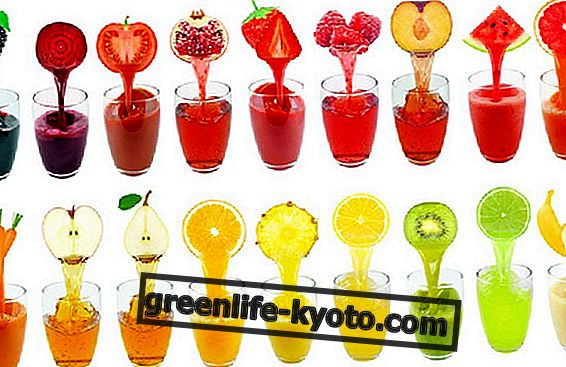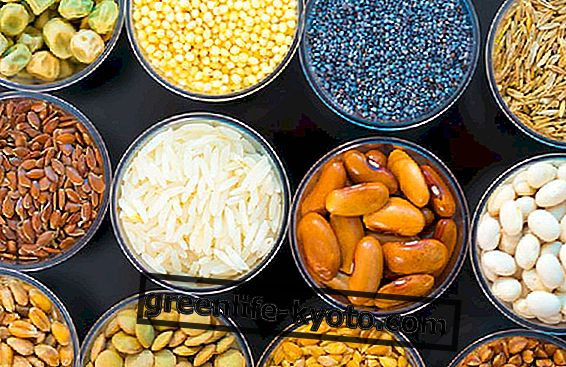
The practice of drinking vegetable juices is present in the hygienist philosophy, in detoxification techniques, in natural nutrition in general and in particular in raw food, in theory for maintaining the right pH by choosing alkalizing foods and finally in the field of natural cures such as in naturopathy.
The preparation of fresh juices and their intake is recommended for at least 0.5 liter per day . This quantity is indicated by Norman Walker, pioneer of raw food and experimenter of plant extracts.
At the end of the 1900s Norman worked and used these juices to improve the state of health and solve various disorders and diseases obtaining excellent results on the people treated.
Which vegetable to choose for making juices
The most common vegetables and vegetables we have in our kitchens are the same as those that serve us as ingredients for our juices.
Vegetables in which the usable part is the fruit : tomato, pepper, aubergine, cucumber, courgette, pumpkin.
Useful vegetables for juices extracted from the leaf : chard, spinach, salad, rocket, radicchio, various cabbage.
Vegetables that we collect the part of stem or root : beetroot, radish, daikon, celery, fennel, sedanorapa, carrot, leek, onion.
Here are 3 fruit and vegetable extracts for your body
How to prepare vegetable juices
There are many ways to get vegetable juice. On the market we find ready-made vegetable juices in which, however, usually the pasteurization or sterilization of the product considerably reduces the presence of nutraceutical substances and consequently also the beneficial properties of the juice.
If we prepare a juice at home it will be fresh and full of all those substances that are so important in vegetables, such as vitamins, minerals and phytosubstances .
First of all it will be necessary to find fresh vegetables and preferably from organic farming. The starting material must be extremely fresh and healthy. Excellent plant products harvested and cultivated in a DIY way on the balcony vegetable garden or in your own family garden.
Choosing seasonal vegetables is preferable because it allows you to minimize the risk of pesticides or chemical residues and unlike vegetables grown outside their natural season.
The vegetables, after having been cleaned and washed, are used to obtain fresh juice. This juice should be consumed immediately, at the time. In fact , storage is not allowed : even if it happened in the refrigerator and in a closed bottle, it is not indicated precisely because it would still lose valuable nutrients and beneficial substances for the juice, such as vitamin C , vitamin E and vitamin A.
Furthermore, the oxidation process takes place when the juice comes into contact with the air causing the transformation of the substances and the consequent loss of their benefits.
Tools for making vegetable juices
The three most used instruments are the blender (glass or immersion), the centrifuge and the extractor .
- The blender needs to be powerful enough to be able to chop leathery vegetables like the roots and this is not always possible. You must also add a liquid, such as water, milk or vegetable milk to better blend vegetables. You will get an elongated juice and increased any substances of the added liquid. However, it remains a fast, easy and inexpensive method.
- The centrifuge is a household appliance invented to produce juices. Through a basket that rotates at high speed and thanks to the centrifugal force, it succeeds in letting the juice that flows into the container below the filter come out from the vegetable cells. The centrifuged juice obtained is 100% vegetable without the addition of liquids, although some substances may still have been lost during centrifugation due to friction and overheating of the moving appliance. Pretty fast method, a bit more expensive tool and average efficiency. A disadvantage is the cleaning of the internal gears which varies according to the brands and models.
- The extractor is a sophisticated appliance that has been specifically designed to extract fruit and vegetable juices with maximum efficiency. It works with a cochlea that crushes the vegetable to obtain its juice. The extraction efficiency is among the best ever, it is silent and easy to clean. The speed of the movement is very low and this allows not to lose substances and active ingredients. Surely the disadvantage is the cost of the appliance and this must be evaluated according to the frequency of use in the family.
Types of juices
There are many vegetable juices and, depending on the starting vegetable and the combinations, we can have energizing juices, detoxifying, vitamins, and more generally they help the well-being of specific apparatuses (for example the digestive one) or that calm or support the whole organism.
- Energizers: with spinach and green apples or asparagus, celery and carrots.
- Vitamin: with beetroot and pear or courgette, tomato and basil.
- Detoxifying: with celery, fennel and apple or red cabbage and apple.
Pros and cons of vegetable juices
As we have seen, every method of extraction with a blender, centrifuge or extractor has its pros and cons. The best method to maintain all the properties, having maximum efficiency and obtaining all the advantages of fresh juices is certainly the extractor, but it is also the most expensive in economic terms.
If the use of vegetable juices becomes part of the eating habits of the whole family then this expense will also be sustainable for the well-being of all the components.
The pro of vegetable juices is the intake of large quantities of mineral salts and vitamins, antioxidants and phytonutrients and all those nutraceutical or active-effect substances that are able to protect and treat the body in addition to nourishing it in a healthy way and balanced.
A counter of vegetable juices is the possibility of thinking that once you have drunk the juices it is not necessary to eat raw or cooked vegetables. It should be noted that part of the fiber is absent from vegetable juice .
It is important to take fiber in the right quantities : in fact, while on the one hand it serves the body to cleanse and detoxify, on the other hand too much fiber can give problems and we must pay attention above all to growing children who still have immature digestive tract.
The juice is easier to consume than raw or cooked vegetables but should not be a substitute for solid plant foods, rather in addition to daily eating habits.













